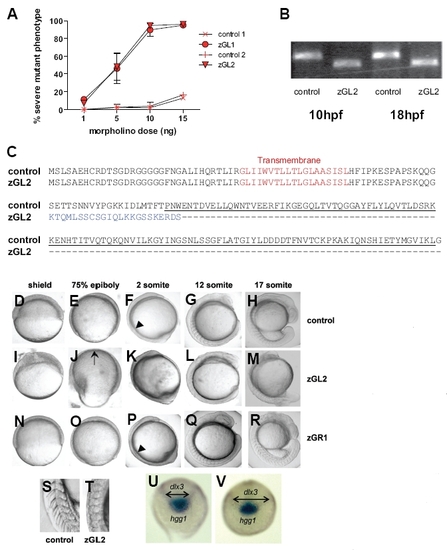
Morpholino oligonucleotide knock-down of gitrl during early development. (A) Embryos injected with increasing amounts of zGL1 (translation block), zGL2 (splicing block) or control MO were scored at 24 hpf for occurrence of a severe mutant phenotype defined by lack of clear somite boundaries and significant shortening of the embryo. The results are shown graphically as a mean percentage of total embryos injected ± SD of three experiments, with a minimum of 50 embryos injected per MO dose per experiment. Both zGL1 and zGL2 were equivalent in mediating the mutant effect which was not observed with control MOs. (B) The efficiency and persistence of the splice-blocking MO zGL2 were confirmed using RT-PCR. Following injection of 10 ng of zGL2, but not control MO, a smaller gitrl amplification product, diagnostic for the absence of exon 2, was obtained. The effect of zGL2 on splicing remained fully effective to at least 18 hpf. (C) To confirm the omission of exon 2, transcripts were cloned from zGL2 and control MO injected embryos and a total of 24 control and 48 zGL2 derived clones sequenced. All of the zGL2 derived clones displayed exon 1-3 splicing. This mis-splicing introduced a frameshift mutation such that the TNF family domain region, underlined, would be replaced by an alternative, tuncated C-terminus, indicated in blue. All of the control clones contained the full-length gitrl sequence. (D-R) Embryos injected with control, zGL2 and zGR1 MOs were compared from early gastrula through late segmentation stages. During gastrulation the blastoderm margin was poorly defined at the shield stage (I) in zGL2 morphants and did not advance to cover the whole of the yolk cell (J). Embryos tended to become mildly deformed during epiboly and the dorsal thickening and ventral thinning that is characteristic of late gastrulation was mispositioned in approximately 50 % of the embryos as indicated by the arrow in (J). In contrast both control (D,E) and zGR1 (N,O) MO-injected embryos remained phenotypically normal during gastrulation. The first somite boundary was clearly delineated in control (arrowhead in (F)) and zGR1 (arrowhead in (P)) but not in zGL2 morphant (K) embryos. Abnormal somite shape, optic primordium and head shape can be seen in (L). By late segmentation, zGL2 MO-injected embryos were significantly shorter with abnormal yolk extensions and abnormally-shaped somites (M). A magnified view of the posterior somites clearly shows the normal chevron shape in controls (S) and the abnormal shape and less-clearly defined boundaries in zGL2 morphants (T). (Equivalent phenotypes were also observed using the zGL1 and zGR2, data not shown). (U) Control or (V) gitrl morphants were probed at the tail-bud stage (10 hpf) using antisense RNA probes specific for hgg1 and dlx3. Double-headed arrows indicate the increased width of the dlx3 expression domain in gitrl morphants relative to control embryos. Data are representative of embryos from at least three independent experiments in which a minimum of thirty embryos per MO per experiment were injected.
|

